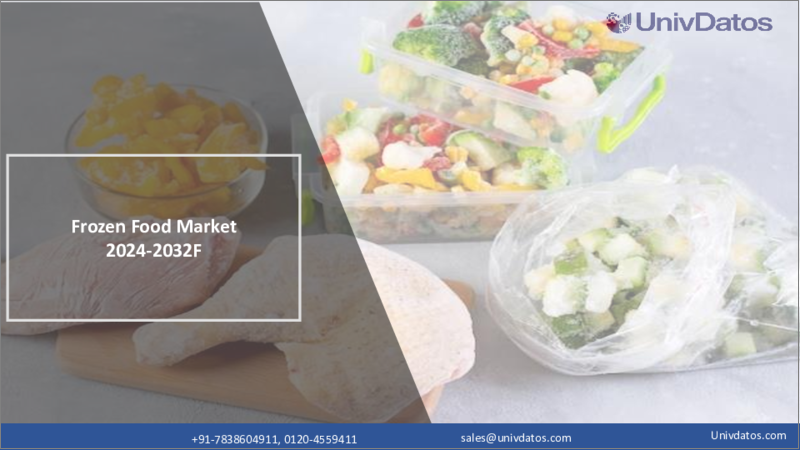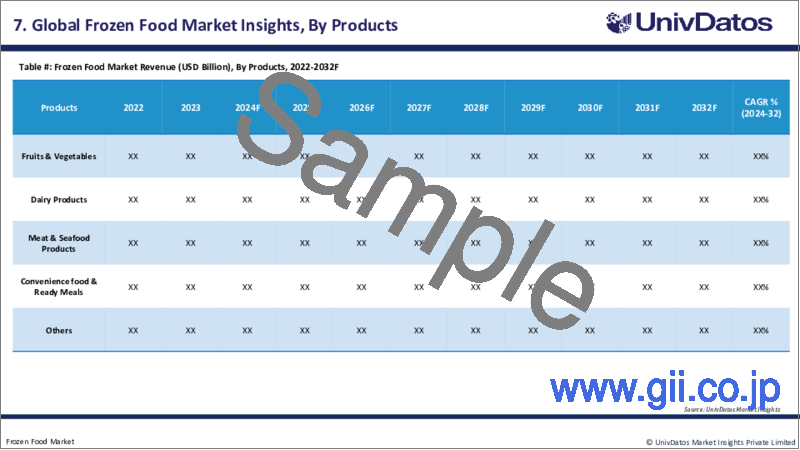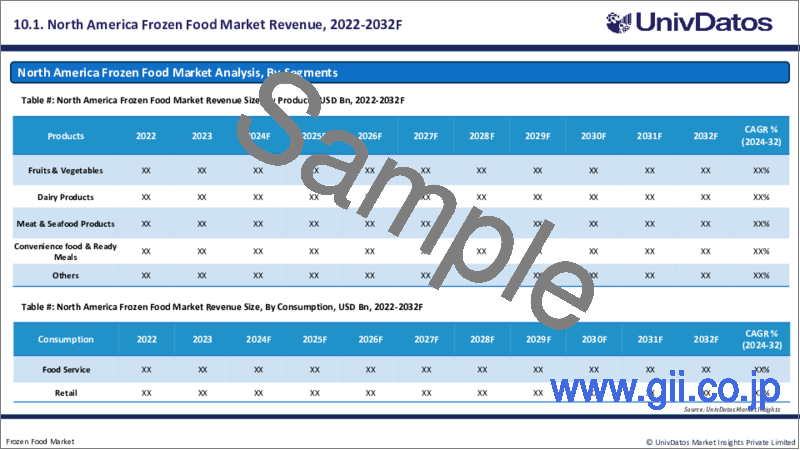|
|
市場調査レポート
商品コード
1570987
冷凍食品市場:現状分析と予測(2024年~2032年)Frozen Food Market: Current Analysis and Forecast (2024-2032) |
||||||
カスタマイズ可能
|
|||||||
| 冷凍食品市場:現状分析と予測(2024年~2032年) |
|
出版日: 2024年09月01日
発行: UnivDatos Market Insights Pvt Ltd
ページ情報: 英文 141 Pages
納期: 即日から翌営業日
|
全表示
- 概要
- 目次
冷凍食品市場は、コンビニエンスフードや時間節約型ミールソリューションへの需要の高まりにより、予測期間において5.10%の安定した成長率で推移しています。最近の冷凍食品市場は、特に多忙な現代社会におけるコンビニエンスフードの市場動向の高まりにより、急速に発展しています。人々は仕事に忙殺され、生活水準も高くなっているため、冷凍食品のような便利な製品を必要としています。このような動向は、冷凍技術の発展や、より優れた包装資材の入手可能性によってさらに促進され、冷凍製品の栄養や品質の向上につながっています。ここでいう便利さとは、惣菜だけでなく、おいしくて新鮮な食品を簡単に調理できる冷凍食品を指します。さらに、棚に並べられた冷凍食品の表示面は、鮮度だけでなく、食品廃棄物の削減や、環境に優しい製品を求める消費者の欲求にも関係しています。従って、冷凍食品の消費は、特に発展途上国における雇用と都市化を考慮すれば、今後も同様に伸び続けると予想されます。
この傾向を浮き彫りにする最近の事例や動向には次のようなものがあります:
例えば2023年、米国冷凍食品研究所(AFFI)の報告書によると、米国における冷凍食品の売上高は2022年に722億米ドルに達し、パンデミック(世界的大流行)の間に達成された利益を維持しています。これは、2019年のパンデミック前の水準と比較して23%の増加です。
2023年9月には、B&G FoodsのブランドであるGreen Giantが9つの新しい冷凍野菜製品を市場に投入しました。
したがって、コンビニエンスフードと時間を節約できる食事ソリューションに対する需要の高まりが、冷凍食品市場を世界的に牽引しています。
冷凍食品市場は、製品別に果物・野菜、乳製品、肉・魚介類、コンビニエンスフード・調理済み食品、その他に区分されます。調理に必要なものが限られているため、調理済み食品は消費者に他の選択肢よりもコンビニエンスフードを優先するよう促しています。同様に、都市化が加速するにつれて、時間を重視する都市の増加により、コンビニエンスフードの必要性が高まっています。2023年には、Tyson Foodsが冷凍鶏肉アイテムの生産管理を強化する措置をとり、より迅速でタンパク質が豊富な代替食品への需要が高まるにつれて、冷凍製品ラインを拡大しました。加えて、冷凍技術の開発が惣菜の品質と風味を強化し、冷凍コンビニエンスフードに対する消費者の信頼を高めています。このセクションはさらに、ピザ、冷凍ディナー、スナック菓子など、便利な食品の選択肢を幅広く提供し、幅広い嗜好と嗜好を引きつけて、その人気をさらに高めています。
消費に基づいて、冷凍食品市場は外食と小売に二分されます。2023年にはフードサービス分野が市場を独占しており、予測期間中も同様の動きをすると予想されます。成長の主な要因としては、レストランやファストフードチェーンからの需要の高まりが挙げられます。ファーストフードチェーンは、顧客に提供する食事を即座に準備するために冷凍食品に大きく依存しています。また、多忙なライフスタイルや多種多様な料理により、調理済み食品や加熱調理済み食品の人気と消費がここ数年で高まっており、このセグメントの成長を後押ししています。例えば、Walmartは冷凍食品セグメント、特に栄養価の高さから需要の高い植物由来の製品を増やしました。さらに、効率的なコールドチェーンロジスティクスと保管ソリューションの開発により、外食業者は冷凍食品の在庫へのアクセスと管理が容易になり、供給の継続性が確保され、腐敗が減少しました。
冷凍食品市場は、流通チャネルによってオフラインとオンラインに区分されます。過去1年間はオフライン部門が市場を独占しており、予測期間もオフライン部門が支配すると予想されます。冷凍食品はスーパーマーケット、ハイパーマーケット、コンビニエンスストアで需要があります。また、これらの店舗では一般的な外観が陳列されており、顧客が商品と物理的に接触することで、その商品を購入する可能性が高いです。現在、ほとんどの消費者は実店舗で冷凍食品を購入することを好むが、それは消費者が近代的な買い物方法を採用しておらず、スーパーマーケットの商品が新鮮で高品質であることを信頼しているからです。例えば、欧州のテスコは、植物由来やオーガニックの冷凍食品を増やすことで、健康に気を配る消費者の増加に対応する冷凍食品の品揃えを増やしました。オフラインの店舗では、ブランドとプライベートブランドの両方の冷凍食品を数多く取り揃えており、継続的なプロモーションやキャンペーンによって、より多くの消費者が実店舗で買い物をするよう誘引しています。冷凍食品は実店舗の特定の場所に置かれ、特にオフラインセグメントにとっては購買意欲をそそる機能を備えています。
冷凍食品市場をより深く理解するために、市場は北米(米国、カナダ、その他北米地域)、欧州(ドイツ、英国、フランス、イタリア、スペイン、その他欧州地域)、アジア太平洋地域(中国、日本、インド、その他アジア太平洋地域)、世界のその他の地域における世界のプレゼンスに基づいて分析されます。北米の冷凍食品市場は現在、圧倒的なシェアを誇っており、予測期間中も圧倒的なシェアを維持すると予測されています。米国とカナダを中心とする北米の冷凍食品産業は、技術革新と顧客動向の変化により速いペースで成長しています。この市場を支えているのは、品目をより良い品質で冷凍する先進的な冷凍庫と、品目に簡単にアクセスできるパッケージングです。業界の主要企業には、ConAgra Foods社、General Mills社、Kraft Heinz社などがあり、これらの企業は新しい動向に対応するために製品ポートフォリオを多様化しているが、冷凍食品業界は激しい競合によって特徴付けられています。また、eコマースの拡大により、冷凍食品の市場が拡大し、コールドチェーン技術も向上しています。さらに、健康的な生活に対する意識が高まっており、このことがメーカーに、より高品質の冷凍食品、それもオーガニックの冷凍食品を提供するようプレッシャーをかけているため、市場が拡大しています。例えば、2023年6月、ConAgra Foods社は、冷凍食品市場における健康志向の高まりに基づき、有機冷凍食品の新ラインを発表しました。これらの製品は、食事時のジレンマを解決し、欲求を満たすことで、消費者の期待に応えるように設計されています。
市場に参入している主要企業には、Unilever, Nestle, The Kraft Heinz Company, General Mills Inc., Cargill, Incorporated, Ajinomoto Co., Inc., WK Kellogg Co, Conagra Brands, Inc., Tyson Foods, Inc., FRoSTA AGなどがあります。
目次
第1章 市場イントロダクション
- 市場の定義
- 主な目的
- ステークホルダー
- 制限事項
第2章 調査手法または前提条件
- 調査プロセス
- 調査手法
- 回答者プロファイル
第3章 エグゼクティブサマリー
- 業界要約
- セグメント別見通し
- 市場成長の強さ
- 地域展望
第4章 市場力学
- 促進要因
- 機会
- 抑制要因
- 動向
- PESTEL分析
- 需要側分析
- 供給側分析
- 合併と買収
- 製品発売
- 業界考察:大手スタートアップ企業とその独自の戦略
第5章 価格分析
- 地域別価格分析
- 価格に影響を与える要因
第6章 世界の冷凍食品市場収益、2022-2032年
第7章 市場洞察:製品別
- 果物・野菜
- 乳製品
- 肉・魚介類製品
- コンビニエンスフード・調理済み食品
- その他
第8章 市場洞察:消費別
- フードサービス
- 小売
第9章 市場洞察:流通チャネル別
- オフライン
- オンライン
第10章 市場洞察:地域別
- 北米
- 米国
- カナダ
- その他北米地域
- 欧州
- ドイツ
- 英国
- フランス
- イタリア
- スペイン
- その他欧州地域
- アジア太平洋地域
- 中国
- 日本
- インド
- その他アジア太平洋地域
- 世界のその他の地域
第11章 バリューチェーン分析
- 限界分析
- 市場参入企業一覧
第12章 競合情勢
- 競合ダッシュボード
- 競合市場ポジショニング分析
- ポーターのファイブフォース分析
第13章 企業プロファイル
- Unilever
- Nestle
- The Kraft Heinz Company
- General Mills Inc.
- Cargill, Incorporated
- Ajinomoto Co., Inc.
- WK Kellogg Co
- Conagra Brands, Inc.
- Tyson Foods, Inc.
- FRoSTA AG
第14章 頭字語と前提条件
第15章 付録
The Frozen Food Market is growing at a steady rate of 5.10% in the forecast period due to the growing demand for convenience foods and time-saving meal solutions. Over the recent past, the frozen food market has been rapidly developing, primarily as a result of an increasing market trend of convenience foods especially in the current busy world. People are busy with their jobs and have higher standards of living and hence require convenient products like frozen products. This trend is further promoted due to developments in freezing technology and the availability of better packaging materials which has led to better nutrition and quality of these frozen products. What is meant by convenience here is not just referring to ready meals but other frozen foods that allow one to prepare delicious and fresh foods with much ease. Furthermore, the indicated aspect of frozen foods on the shelf relates not only to freshness but also to the reduction of food waste and consumer desire for environmentally friendly products. Hence, consumption of frozen foods will equally continue to grow given employment and urbanization, especially in developing countries, which are also likely to continue to alter consumer food trends and choices in the years ahead.
Recent instances and developments highlighting this trend include:
For instance, in 2023, according to a report by the American Frozen Food Institute (AFFI), frozen food sales in the United States reached USD 72.2 billion in 2022, maintaining the gains achieved during the pandemic. This represents a 23% increase compared to 2019 pre-pandemic levels.
In September 2023, Green Giant, a B&G Foods brand introduced 9 new frozen vegetable products in the market.
Therefore, the growing demand for convenience foods and time-saving meal solutions drives the frozen food market globally.
Based on the products, the frozen food market is segmented into fruits and vegetables, dairy products, meat & seafood products, convenience food & ready meals, and others. Due to their limited preparation requirements, ready-to-eat meals inspire consumers to prioritize convenience food over other choices. Likewise, as urbanization accelerates, there is a greater requirement for convenience foods due to the rise of cities valuing time. In 2023, Tyson Foods took enhanced action to administrate the production of its frozen chicken items, expanding its frozen product line as demand for quicker, protein-rich alternatives approaches an increase. In addition, developments in freezing techniques have strengthened the quality and flavor of ready meals, thus raising consumer confidence in frozen convenience foods. This section additionally provides a wide array of convenient food options, inclusive of pizzas, frozen dinners, and snacks, which attract a big spectrum of tastes and preferences, driving its popularity even higher.
Based on consumption, the frozen food market is bifurcated into food service and retail. The food service segment dominated the market in 2023 and is expected to behave in the same fashion in the forecast period. The major factors contributing to the growth include the rising demand from restaurants and fast-food chains. Fast-food chains heavily rely on frozen food for the instant preparation of meals to serve the customers. Additionally, the growing popularity and consumption of Ready-to-Cook and Heat-and-Eat Options has increased in the last couple of years due to busy lifestyles and a wide variety of available cuisines, which has bolstered the segment's growth. For instance, Walmart increased its frozen food segment, especially plant-based products that are in high demand due to their nutritional value. Furthermore, the development of efficient cold chain logistics and storage solutions has made it easier for food service providers to access and manage frozen food inventories, ensuring supply continuity and reducing spoilage.
Based on distribution channels, the frozen food market is segmented into offline and online. The offline segment has dominated the market in the historic year and is expected to dominate in the forecast period. Frozen food has its demand in supermarkets/hypermarkets/ convenience stores which gives consumers access to many numbers of products. These outlets also display general appearance and when a customer has any physical contact with products then they are likely to buy them. Currently, most consumers prefer to purchase frozen foods from physical stores because they have not adopted the modern method of shopping and trust supermarket products to be fresh and quality. For instance, Europe's Tesco expanded its range of frozen food that caters to the increasing number of consumers concerned with their health through the addition of more plant-based and organic frozen meals. Offline stores provide a large range of frozen foods, both branded and private label with- ongoing promotions and offers that entice more consumers to shop physically. Frozen foods are located in certain places in physical stores with the ability to entice one to purchase them, especially for the offline segment.
For a better understanding of the frozen food market, the market is analyzed based on its worldwide presence in countries such as North America (The US, Canada, and Rest of North America), Europe (Germany, The UK, France, Italy, Spain, Rest of Europe), Asia-Pacific (China, Japan, India, Rest of Asia-Pacific), Rest of World. The North America frozen food market currently dominates and is expected to dominate in the forecasted period. The frozen food industry in North America, primarily in the United States and Canada, is growing at a fast pace due to innovations in technology and changing customer trends. The market is supported by advanced freezers that freeze items to a better quality and packaging that makes the items easily accessible. Some of the leading companies in the industry include ConAgra Foods, General Mills, and Kraft Heinz and while these players are diversifying their product portfolios to meet the new trends, the frozen food industry is characterized by intense competition. Also, the expansion of e-commerce has enabled a wider market for frozen foods and better cold chain technologies. Additionally, there is growing awareness of healthy living, and this is putting pressure on the manufacturers to provide better quality frozen foods, that are organic, hence extending the market. For instance, in June 2023, ConAgra Foods released its new line of organic frozen meals based on the increasing focus on healthier foods in the frozen food market. These products are designed to meet consumer expectations by solving mealtime dilemmas and satisfying cravings.
Some of the major players operating in the market include Unilever, Nestle, The Kraft Heinz Company, General Mills Inc., Cargill, Incorporated, Ajinomoto Co., Inc., WK Kellogg Co, Conagra Brands, Inc., Tyson Foods, Inc., and FRoSTA AG.
TABLE OF CONTENTS
1.MARKET INTRODUCTION
- 1.1. Market Definitions
- 1.2. Main Objective
- 1.3. Stakeholders
- 1.4. Limitation
2.RESEARCH METHODOLOGY OR ASSUMPTION
- 2.1. Research Process of the Frozen Food Market
- 2.2. Research Methodology of the Frozen Food Market
- 2.3. Respondent Profile
3.EXECUTIVE SUMMARY
- 3.1. Industry Synopsis
- 3.2. Segmental Outlook
- 3.2.1. Market Growth Intensity
- 3.3. Regional Outlook
4.MARKET DYNAMICS
- 4.1. Drivers
- 4.2. Opportunity
- 4.3. Restraints
- 4.4. Trends
- 4.5. PESTEL Analysis
- 4.6. Demand Side Analysis
- 4.7. Supply Side Analysis
- 4.7.1. Merger & Acquisition
- 4.7.2. Product Launch
- 4.7.3. Industry Insights: Leading Startups and Their Unique Strategies
5.PRICING ANALYSIS
- 5.1. Regional Pricing Analysis
- 5.2. Price Influencing Factors
6.GLOBAL FROZEN FOOD MARKET REVENUE (USD BN), 2022-2032F
7.MARKET INSIGHTS BY PRODUCTS
- 7.1. Fruits & Vegetables
- 7.2. Dairy Products
- 7.3. Meat & Seafood Products
- 7.4. Convenience food & Ready Meals
- 7.5. Others
8.MARKET INSIGHTS BY CONSUMPTION
- 8.1. Food Service
- 8.2. Retail
9.MARKET INSIGHTS BY DISTRIBUTION CHANNEL
- 9.1. Offline
- 9.2. Online
10.MARKET INSIGHTS BY REGION
- 10.1. North America
- 10.1.1. The US
- 10.1.2. Canada
- 10.1.3. Rest of North America
- 10.2. Europe
- 10.2.1. Germany
- 10.2.2. The UK
- 10.2.3. France
- 10.2.4. Italy
- 10.2.5. Spain
- 10.2.6. Rest of Europe
- 10.3. Asia-Pacific
- 10.3.1. China
- 10.3.2. Japan
- 10.3.3. India
- 10.3.4. Rest of Asia-Pacific
- 10.4. Rest of World
11.VALUE CHAIN ANALYSIS
- 11.1. Marginal Analysis
- 11.2. List of Market Participants
12.COMPETITIVE LANDSCAPE
- 12.1. Competition Dashboard
- 12.2. Competitor Market Positioning Analysis
- 12.3. Porter Five Forces Analysis
13.COMPANY PROFILED
- 13.1. Unilever
- 13.1.1. Company Overview
- 13.1.2. Key Financials
- 13.1.3. SWOT Analysis
- 13.1.4. Product Portfolio
- 13.1.5. Recent Developments
- 13.2. Nestle
- 13.3. The Kraft Heinz Company
- 13.4. General Mills Inc.
- 13.5. Cargill, Incorporated
- 13.6. Ajinomoto Co., Inc.
- 13.7. WK Kellogg Co
- 13.8. Conagra Brands, Inc.
- 13.9. Tyson Foods, Inc.
- 13.10. FRoSTA AG





